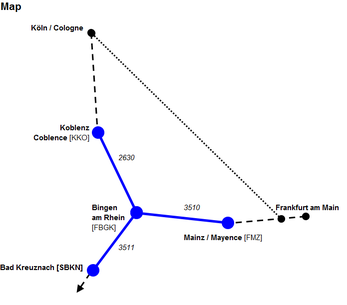IS:openEnd
openEnd
Schema description / Schemabeschreibung
Position of openEnd in the XML-Tree / Position von openEnd im XML-Baum
- Parent: <trackBegin>, <trackEnd>
- Children: <additionalName>, <any>
Multiplicity / Anzahl
Semantics / Bedeutung
<openEnd> indicates that it is unknown to the modeler how the track continues. Especially, the track may be continued with further track sections, but these sections are not part of the railML® description.
Trains can enter or leave the infrastructure at an <openEnd>. This is a major difference to <bufferStop>, which indicates that a track is terminated without any possibility for trains to enter or leave the track.
The <connection> in other <trackBegin>s and <trackEnd>s, or in <switch>es and <crossing>s, can only reference other <connection>s, not this <openEnd>. The <track> associated with this <openEnd> may therefore not be continued with any other <track>.
Attributes of openEnd / Attribute von openEnd
- id: XML-file-wide unique, machine-interpretable identity, required for later referencing that element internally. For a detailed explanation see Dev:identities.
XML-Datei-weit eindeutige, maschineninterpretierbare Identität, die für die spätere interne Referenzierung dieses Elements erforderlich ist. Für eine detaillierte Erklärung siehe Dev:identities. - code (introduced with version 2.1): Machine-interpretable string (e.g. an abbreviation) used for identification of the object across exchange partners, usecase specific uniqueness constraints may apply. Please see our description of the differences between id, code and human-readable identifiers.
Maschineninterpretierbare Zeichenkette (z.B. Abkürzung), die zur Identifizierung des Objekts auch bei Austauschpartnern verwendet wird, wobei spezifische Eindeutigkeitsbeschränkungen gelten können. Bitte beachten Sie unsere Erläuterung zu den Unterschieden zwischen id, code and menschenlesbaren Kennzeichnungen. - name: Established, human-readable short string, giving the object a name. Not intended for machine interpretation, please see our notice on human interpretable data fields.
Etablierte, menschenlesbare kurze Zeichenkette, die das Objekt benennt. Nicht zur maschinellen Interpretation bestimmt, siehe Hinweise zu menschenlesbaren Datenfeldern. - description: Human-readable, more detailed description as addition to the name. It should give additional explanations or hints to the contents of this element. Not intended for machine interpretation, please see our notice on human interpretable data fields.
Menschenlesbare, detailliertere Beschreibung als Ergänzung zu name. Sie soll zusätzliche Erläuterungen oder Hinweise auf den Inhalt dieses Elements geben. Nicht zur maschinellen Interpretation bestimmt, siehe Hinweise zu menschenlesbaren Datenfeldern. - xml:lang (introduced with version 2.1): This is a unique identifier of language. It uses basically the language standard IETF BCP 47 (external link) which may be different to ISO 639-1 (external link) or ISO 639-2 (external link). For mapping hints see relation to other standards (external link).
This defines the language used for name and description. Use <additionalName> to provide a name and/or description in other languages.
Syntactic Constraints / Syntaktische Beschränkungen
- id: xs:ID, required
a string, starting with a letter (a..zA..Z) or an underscore (_),
followed by a non-colonized and non-spaced string consisting of letters, digits, points (.), dashes (-) or underscores (_) - code: xs:string, optional
- name: xs:string, optional
- description: xs:string, optional
- xml:lang: xs:language, language identification, optional
Best practice & Examples / Empfohlene Anwendung & Beispiele
Consider the railML® 2.3 example of Middle Rhine Railway by GPSinfradat (link to the railML® website).
| TrackID | LineID | BeginElementType | EndElementType | OCP Start | OCP End |
|---|---|---|---|---|---|
| 26301 | 2630 | oE | mN | KKO | FBGK |
| 35102 | 3510 | oE | mN | FMZ | FBGK |
| 35113 | 3511 | mN | oE | FBGK | SBKNG |
This code example defines a track begin that is an open end.
<trackBegin id="tB26301" pos="0" absPos="91050"> <openEnd id="oEb26301"/> </trackBegin>
Notes / Anmerkungen
Not yet described. / Noch nicht beschrieben.
Open issues / Offene Punkte/Pendenzen
Not yet described. / Noch nicht beschrieben.
